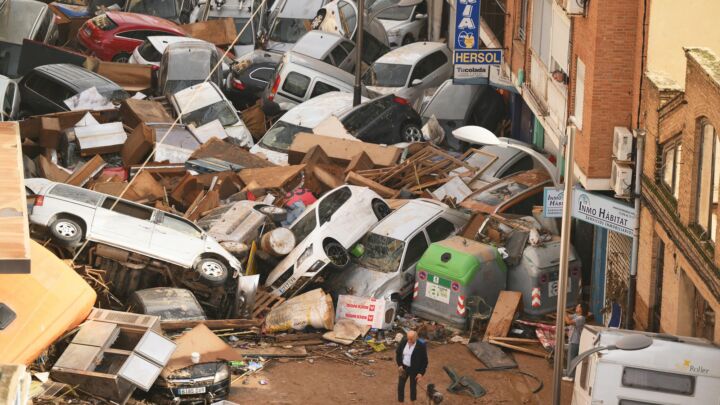Costa Concordia: a vessel for anti-consumerist angst
Some observers are tastelessly leaping on board the sunken ship to pontificate about the decadence and folly of big, brassy cruise-liners.

Want to read spiked ad-free? Become a spiked supporter.
The sequence of events that led to the sinking of the luxury cruise liner, the Costa Concordia, is now pretty much established. But facts have not got in the way of a variety of commentators who are using the accident to parade their prejudices about too-big ships and ignorant passengers.
On Friday evening, at approximately 9.30pm, the ship was passing Giglio, a small island off the coast of Tuscany. Unfortunately, the Concordia was three miles off course from its usual route. Too close to the island, the liner hit a rocky outcrop which tore a 160ft hole in its hull. Though listing, the crew managed to sail the Concordia closer to shore where it partially capsized. Of its 3,216 passengers and 1,068 crew members, six people have so far been confirmed dead while, at the time of writing, 29 more are still unaccounted for (although there is confusion over the number of people missing).
These are the tragic facts so far. What no one knows exactly is why it happened. Explanations have been mooted, of course: a power blackout affecting the ship’s steering; inaccurate navigation charts failing to show the rocks; or human error, in particular by the ship’s captain, Francesco Schettino. Yet while the exact reason for the ship straying off course remains unclear, that has not stopped another object of blame coming to the fore in some of the coverage. That is, the real, underlying reason for the Costa Concordia accident is to be sought not in the actual events of Friday evening but rather in the profit-driven, build-’em-high cruise industry and, by association, in the sea-faring ignorance of all those who sailed aboard her.
This is why so much of the coverage seems obsessed with the size of the Costa Concordia. Over the past few days, we have been repeatedly told that cruise ships have doubled in size over the past decade. While this is true – and as the twenty-sixth-largest liner in the world, the Costa Concordia is far from the most impressive of this new breed of ships – the Concordia’s size does not actually tell us why it was three miles off course. Nor does it explain why the ship’s crew was unaware of the rock outcrop despite having navigation equipment. Yes, perhaps ship size does affect manoeuvrability, but would a smaller vessel not have suffered a similar fate that befell the Concordia? In fact, the obsession with the ship’s size sheds very little light on what happened to the Concordia on Friday evening.
What the convenient obsession with size draws upon, rather, is an antipathy towards the cruise industry, a sense that it is little more than the ocean-going equivalent of that other right-thinking person’s bête noire, Dubai. In other words, a vulgar testament to profit and sky-high consumption. So although size here is not really relevant as a cause of the Concordia’s capsizing, it appears relevant to certain commentators as a symbol of commercial hubris, of complacent materialism.
Hence the barely disguised sneer in the Daily Mail’s description of these ‘gigantic, floating hotels that pass for modern cruise liners’, or the focus in a Guardian article on the ever-increasing number of decks, the ‘additional swimming pools’ and ‘additional leisure facilities’ that have turned ships into skyscrapers so as to ‘increase revenue-earning capacity’.
Another columnist deploys an old sea-dogs’ expression for vessels of which they disapprove: ‘[they are] designed around the dollar sign.’ ‘They are effectively large tower estates lying on their sides’, she continues, ‘with large, airy spaces for dining, golf, ice rinks, cinemas, rock-climbing walls, whatever. The Costa Concordia apparently had a Formula One simulator.’ So virulent is this strain of snobbery, predictably decked out in anti-consumerist attire, that a motor-racing simulator – an indicator, one presumes, of passengers’ naff tastes – is considered relevant to the Concordia disaster.
In a sense, then, the capsizing of the Concordia has acted for some as a morality tale, a call back to Earth for these Hiltons of the Sea. The tale is simple, but righteous: cruise companies have overreached themselves, they have built too big as part of some pernicious desire to make money. And with the Concordia’s sinking, they must now finally recognise that their vaulting ambition has limits. The Independent‘s Simon Calder seems almost to enjoy the frailty now exposed when quoting a martime expert: ‘If there was anyone that thought 100,000-plus tonne ships in the tweny-first-century were unsinkable, they will be thinking again.’
And just as the commercialism of the cruise industry itself is explicitly blamed for Friday night’s tragedy, so the moneyed ignorance and complacency of its customers is tacitly implicated, too. Cocooned in these ‘un-shiplike’ ships, as one commentator puts it, cruise-ship passengers seem oblivious to the mortal peril that lurks so close at hand. ‘Seafaring is a serious business, even on holiday’, the columnist writes, adding ‘however luxuriously and soothingly we disguise it from ourselves, the ocean remains as unforgiving as it was in 1912′.
The message is clear. Cruise ships, stacked sky-high with bars, restaurants and cinemas have blinded people to the harshness and precariousness of being at sea. The Concordia tragedy is not only a slapdown for the cruise industry; it is a reprimand for its complacent, over-comfortable consumers, too.
What very little of the coverage has seen fit to point out, however, is just how safe cruise ships actually are. Yes, there have been accidents. In 2005, for instance, a 70-foot wave damaged the Norwegian Dawn – an ocean liner en route from the Bahamas to New York – leaving several passengers with minor injuries. And, yes, in 2010, two passengers died when three large waves hit the Louis Majesty off the coast of Spain. But given that around 15million people enjoy cruise trips a year, the fatality rate is so small as to be statistically insignificant. In fact, up until Friday’s accident, just 20 people had died during cruise trips over the past couple of decades.
So, as big and as brassy as the current generation of cruise liners are, there is nothing to suggest, as the moralisers jumping aboard the Concordia disaster are currently doing, that these impressively huge vessels are disasters waiting to happen. Instead, we have a definite case of prejudice overriding the tragic facts of the matter.
Tim Black is senior writer at spiked.
Celebrate 25 years of spiked!
A media ecosystem dominated by a handful of billionaire owners, bad actors spreading disinformation online and the rich and powerful trying to stop us publishing stories. But we have you on our side. help to fund our journalism and those who choose All-access digital enjoy exclusive extras:
- Unlimited articles in our app and ad-free reading on all devices
- Exclusive newsletter and far fewer asks for support
- Full access to the Guardian Feast app
If you can, please support us on a monthly basis and make a big impact in support of open, independent journalism. Thank you.







Comments
Want to join the conversation?
Only spiked supporters and patrons, who donate regularly to us, can comment on our articles.